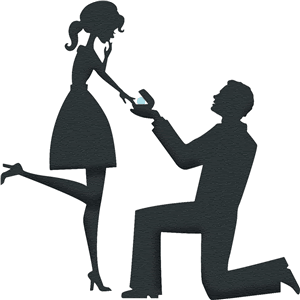
Despite advances in gender equality one tradition persists.
The man in a conventional relationship still steers the proposal agenda.
He decides when and where.
He selects the ring.
Personally, I think that, at the very least, the retail therapy element should be a joint decision.
Of course, the only long-established bugaboo is the element of surprise.
Call me sexist, but what female does not enjoy a good surprise, especially in small packages.
I propose an empty box from a lovely store and an immediate jewelry excursion.
My one meaningful proposal (I actually had 5) was a huge surprise mainly because I never considered marriage.
Some day, when I am feeling no pain, I will tell you the naked truth.
I did not receive the ring during the proposal which provided the opportunity for significant input.
I was consulted and my husband who grew up in South Africa made the perfect diamond geographically accessible.
In life size definitely matters…specifically, offensive linemen, airplanes, master bathrooms, baby making equipment and last, but not least, diamonds.
I was curious where the diamond engagement ring phenomenon started.
It began with the discovery of massive diamond deposits in South Africa in the late 19th century.
Subsequently, South Africa flooded world markets with sparkle.
In 1938, despite political and economic turmoil, the South African company, De Beers, the world’s largest producer and distributor of diamonds, recruited the New York ad agency N.W. Ayer to rev up the desirability of diamonds in the United States.
The practice of giving diamond engagement rings was not yet mainstream and often the diamonds sold were small and low-quality.
That would never do so the folks at Ayer set out to persuade young men that only diamonds were synonymous with romance and that the measure of a man’s love was proportional to the size and quality of the diamond he purchased (again, size matters).
Lights, camera action…Hollywood is always eager to step in, ready for their close up and they played the part convincingly.
Movie idols, the barometers of romance for the masses, were given diamonds to use as their symbols of everlasting love.
In its strategy plan, the DeBeers ad agency outlined a subtle program that included arranging for lecturers to visit high schools across the country.
With the essence of the meet and greet revolving around the diamond engagement ring, the hired diamondeers were able to reach thousands of impressionable female students.
Always mining clients, De Beers sought to expand internationally in the mid-1960s.
The next diamond target was Japan where a long tradition of arranged marriages left little room for romance or diamond engagement rings.
De Beers aggressively marketed diamond rings in Japan as symbols of modern Western values.
At that time, less than 5 percent of married Japanese women had a diamond engagement ring.
By 1981, 60 percent of married Japanese women wore them and Japan had become the second-largest diamond engagement ring market.
China is the next diamond field to be mined.
Bringing things back home, women do a great deal of the heavy lifting during the decades of marriage and want to look good doing it.
Recognizing that the financial burden is on the buyer, I think modern day recipients would be willing to chip in to get the ring of her dreams, especially since women are now a huge part of the work force.
It’s an emotional investment in the future.
After all, diamonds are forever and if the marriage doesn’t work out, diamonds, cracked ceilings or not, are a girls BFF.
Discover more from If The Devil Had Menopause
Subscribe to get the latest posts sent to your email.
Ahh the memories. I worked on the DeBeers advertising account from 1980. My favorite was: “ you didn’t get where you are by following someone else’s footsteps “